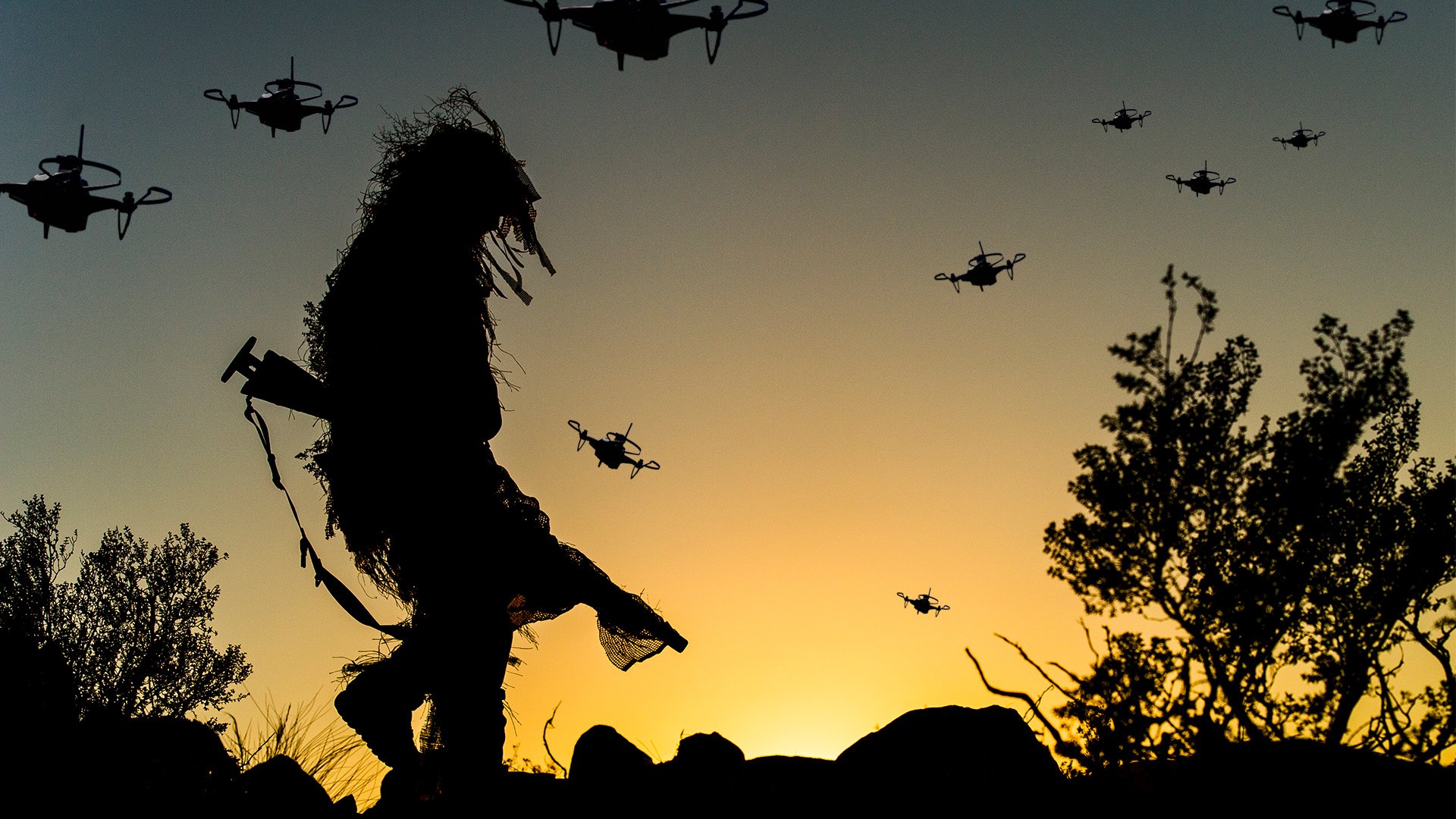
A 7th Special Forces Group sniper walks along a ridge line during on Feb. 17, 2016. At a recent forum on irregulare warfare, two senior Army generals discussed distant but possible changes in Special Forces force structure, including teams of two or even one soldier deploying with swarms of drones. Sniper photo by Tech Sgt. Efren Lopez. Drone image taken at 10th Special Forces Group in 2020, photo by Staff Sgt. Travis Fontane.
The typical image of a Special Forces mission has been the same since the 1950s: A team of 12 soldiers secretly infiltrates a foreign land, perhaps by helicopter or plane. Each is an expert in one area: medical, communications, explosives, etc.
But what if in the future, the Army instead sent two soldiers surrounded by 10 drones? Or just one soldier controlling a swarm of 100 drones?
And will the Army add new military occupational specialties to design, build, and operate battlefield drones?
Two senior Army generals, both longtime special operations veterans, brainstormed last week through a series of seemingly far-fetched ideas about future irregular warfare — including the size and makeup of Special Forces teams — in front of an audience of hundreds of soldiers and Army officials in Fayetteville, North Carolina.
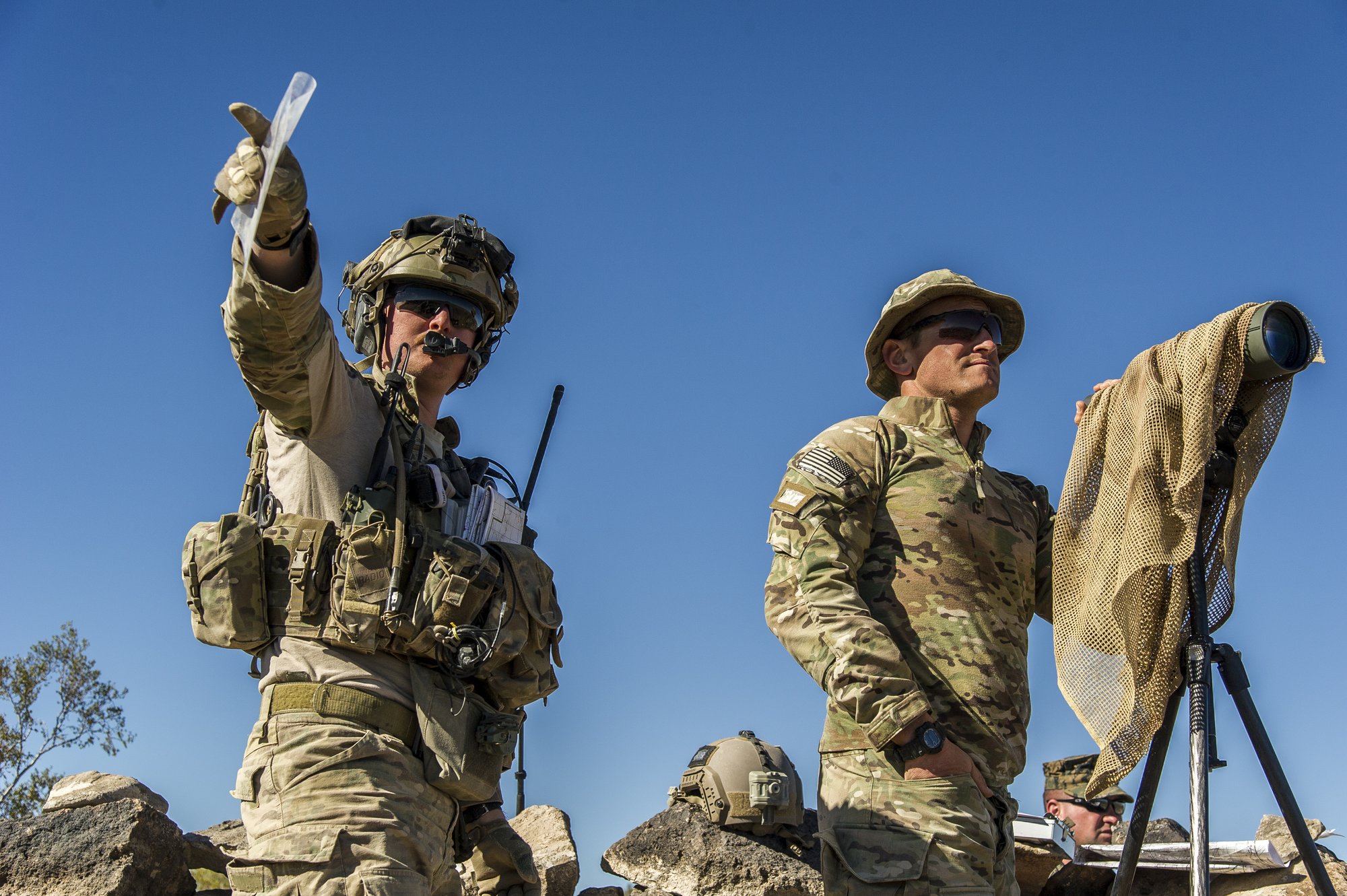
A team with 7th Special Forces Group observe enemy locations during Integrated Training Exercise 2-16 at Marine Corps Air Ground Combat Center, Twentynine Palms, Calif., Feb. 16, 2016. Photo by Tech Sgt. Efren Lopez
Lt. Gen. Jonathan Braga, commander of Army Special Operations Command, and Maj. Gen. Richard Angle mused over what “units of action” — such as pairs of drone-toting soldiers — might look like in the future and whether the Army might need new MOSs. The two spoke on a panel at a Warfighter Symposium hosted by the Association of the Army.
“We're experimenting with our force design and how it works,” Braga said. “What is the [special operations forces] unit of action of the future? Is it two people and 10 drones? One person and a hundred? What's the size of this unit of action? I don’t even like to put a name on it, because as soon as you put a name on it, people start talking in a constrained way. ‘Well, this is a platoon, this is an ODA, this is AOB,’ and you think backwards.”
Angle, the former deputy commander of Joint Special Operations Command, noted that the current structure of a Special Forces team is close to 70 years old.
“Right now, the unit of action in Special Forces is the operational detachment, right?” Angle said, referencing Operational Detachment Alpha, the 12-man teams at the heart of Army Special Forces. “When that operations detachment was built in 1952, it had two people on it. In 1952, they were responsible for primarily operating in three complex environments: land, sea, and air. Today, at that same organization, that unit of action has to operate in land, sea, and air, cyber, and space, and the information environment, and do all the things they were doing previously.”
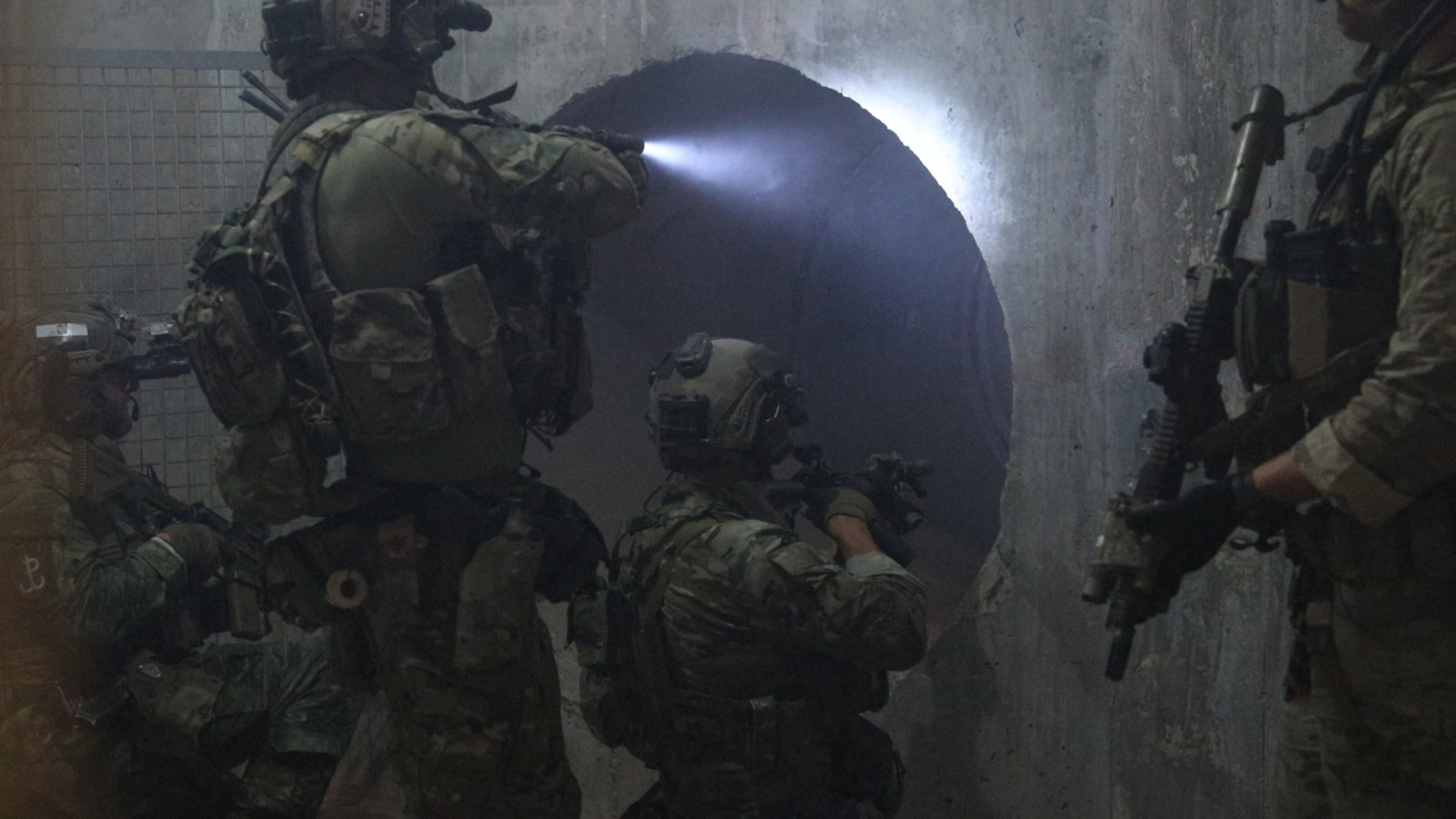
Green Berets assigned to 2nd Battalion, 10th Special Forces Group, train shoulder to shoulder with Polish special operations forces operators at Fort Carson, Colorado, June 2, 2022. US Army photo by Staff Sgt. Anthony Bryant.
Both generals have spent the majority of their careers as Special Forces officers, leading teams of Green Berets and larger units within the Army’s special ops world.
Braga also said that the new skills in special operations will likely mean new MOSs and full-time jobs.
"Do we need new specialties?” Braga asked. “I cannot imagine a future state of warfare that does not have more drone technology and application of AI being part of that team. I do not believe that can be an additional skill on an individual operator. At this time, there's enough overload."
Rather than having traditional Special Forces medics or explosives experts also train in the fast-moving areas of AI and drone use, Braga said, the Army will need soldiers who specialize directly in those fields.
“We have so many talented people in our SOF right now,” Braga said. “Coders, they know Python, they're building their own drones, they're using 3D printers, but we don't have the proper stair, step structure for their career progression to make sure they're successful.”
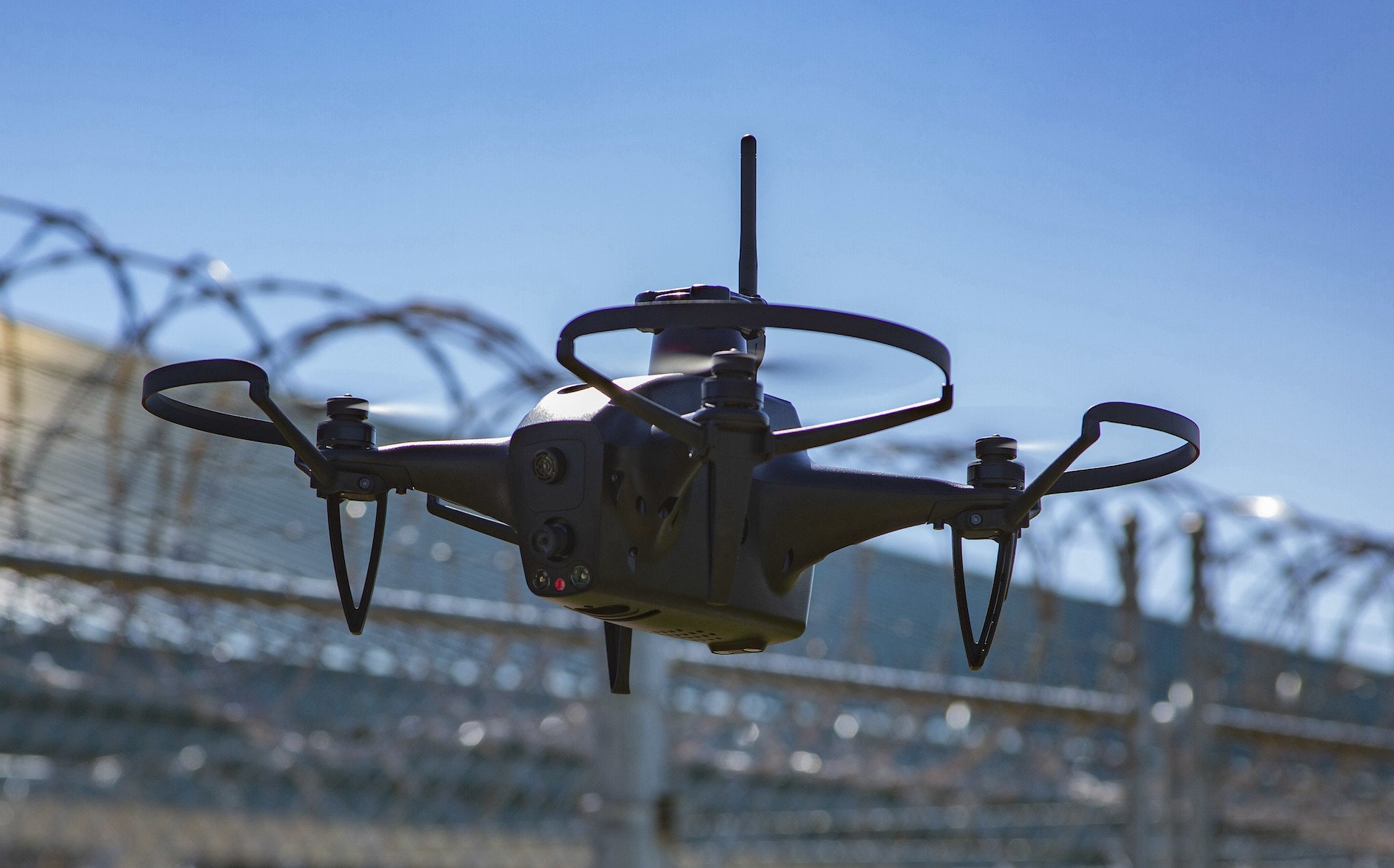
10th Special Forces Group hosted a UAV capabilities display at the group headquarters on August 7, 2020.
Braga told Coffee or Die Magazine that decisions on new MOSs are not likely to be made soon but that staffing officials within US Army Special Operations Command are working to create positions that focus directly on creating hardware and software.
"We’ve already got the people identified,” Braga told Coffee or Die. “The question is getting these E-7s, guys who do this on their own, instead of telling them they have to go do a certain thing [to progress their career], we need to find a place for them to say, ‘Just build me kick-ass drones.’”
Both generals cited the war in Ukraine as a watershed event in the evolution of SOF forces. While unmanned and AI-based systems were used in Afghanistan and Iraq to supplement regular combat units — or, like Predator-style drones, were controlled from far away — drones and online information warfare have been at the heart of daily conflict in Ukraine.
According to Pentagon officials, Ukrainian special operations forces have been using US-made "suicide drones" like the Phoenix Ghost to target Russian forces, with the US committing to send almost 600 of the drones in a recent aid package.
READ NEXT: Team of 101st Airborne Soldiers Claims ‘Best Squad’ Competition
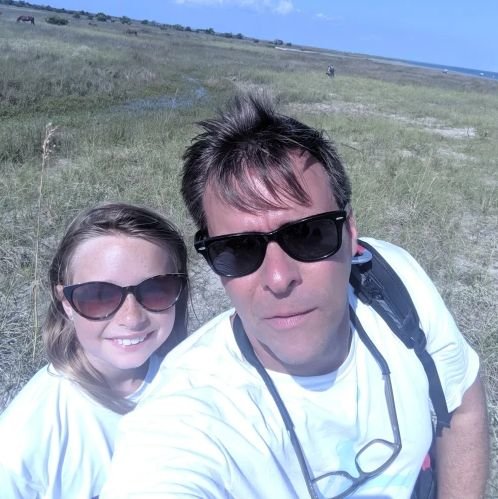
Matt White is a former senior editor for Coffee or Die Magazine. He was a pararescueman in the Air Force and the Alaska Air National Guard for eight years and has more than a decade of experience in daily and magazine journalism.
BRCC and Bad Moon Print Press team up for an exclusive, limited-edition T-shirt design!
BRCC partners with Team Room Design for an exclusive T-shirt release!
Thirty Seconds Out has partnered with BRCC for an exclusive shirt design invoking the God of Winter.
Lucas O'Hara of Grizzly Forge has teamed up with BRCC for a badass, exclusive Shirt Club T-shirt design featuring his most popular knife and tiomahawk.
Coffee or Die sits down with one of the graphic designers behind Black Rifle Coffee's signature look and vibe.
Biden will award the Medal of Honor to a Vietnam War Army helicopter pilot who risked his life to save a reconnaissance team from almost certain death.
Ever wonder how much Jack Mandaville would f*ck sh*t up if he went back in time? The American Revolution didn't even see him coming.
A nearly 200-year-old West Point time capsule that at first appeared to yield little more than dust contains hidden treasure, the US Military Academy said.












